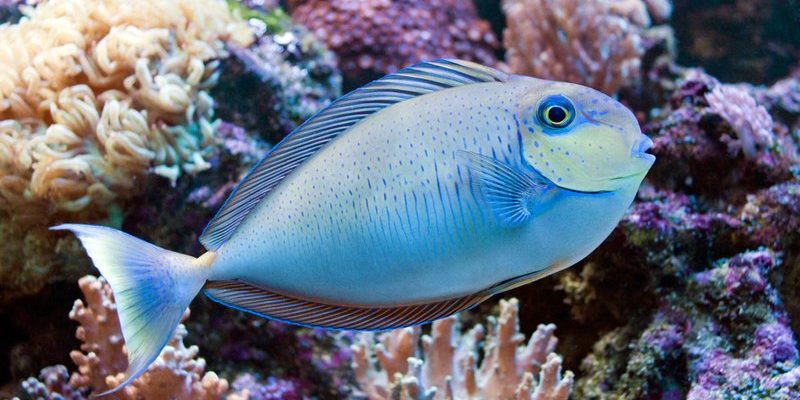
The Vlamingii tang, with its bright blue and yellow hues, is more than just a pretty face. It’s a master at navigating its environment, avoiding predators, and finding food. Understanding these adaptations isn’t just interesting; it can help aquarists create ideal conditions for these fish in home aquariums. So, grab a cup of coffee and let’s take a leisurely swim through the adaptations that make the Vlamingii tang one of nature’s underwater wonders.
Coloration for Camouflage and Communication
One of the first things you’ll notice about the Vlamingii tang is its stunning coloration. With bright blue and yellow fins, it’s like a moving piece of art! But these colors serve more than just aesthetic purposes. Primarily, they provide camouflage. The Vlamingii tang often inhabits coral reefs, where the play of light and shadows can help it blend into the environment. This makes it harder for predators, like larger fish, to spot them.
Additionally, the vivid colors play a vital role in communication. The tang signals to other fish its health and readiness to mate through its bright markings. For instance, when the fish feels threatened, its colors may become duller. This change alerts nearby fish of potential danger, allowing them to react quickly. Isn’t it fascinating how something as simple as color can have such a significant impact on survival?
Spiny Dorsal Fin for Defense
Another remarkable feature of the Vlamingii tang is its spiny dorsal fin. This fin runs along its back and can be raised to stand tall against threats. Imagine it as a shield! When a predator gets too close, the tang can erect its fin, making it appear larger and more intimidating. This can sometimes be enough to deter would-be attackers.
Moreover, these spines are sharp! If a predator bites down, they could end up with a mouthful of spines, leading them to think twice before pursuing the tang. This adaptation is crucial, especially in the competitive and dangerous waters of coral reefs where various species vie for dominance.
Diet Adaptations: Herbivore Specialization
The Vlamingii tang is primarily a herbivore, meaning it mostly feeds on algae and plant matter. To thrive, it has developed a unique set of jaw structures that allow it to graze effectively. Its teeth are sharp and suited for scraping algae off rocks and coral surfaces. Picture a lawn mower that trims grass; that’s how the tang’s mouth works!
This specialization is essential for a couple of reasons. First, algae are abundant in its habitat, providing a constant food source. Second, by feeding on algae, the tang helps maintain the health of coral reefs, preventing overgrowth that can smother corals. By eating algae, it’s not just feeding itself but also playing a role in the larger ecosystem.
Social Behavior: Schooling for Safety
Vlamingii tangs thrive in groups, often forming schools made up of dozens or even hundreds of individuals. This social behavior is not merely for companionship; it serves a strategic purpose. Being in a school provides safety in numbers. When predators approach, the group can quickly scatter, making it harder for the predator to target a single fish.
Moreover, schooling provides opportunities for learning and social interaction. Younger tangs can observe and mimic the behaviors of older, more experienced fish. It’s like a community where the young learn from the wise. These social dynamics contribute to their overall survival and even enhance their ability to find food.
Adaptations to Climate and Environment
Coral reefs can present challenging conditions, such as fluctuating temperatures, salinity levels, and competition for resources. The Vlamingii tang has several physiological adaptations that help it cope with these variations. For instance, it can adjust its breathing patterns based on water temperature to maximize oxygen intake.
The tang’s slim body shape also aids in maneuverability within tight spots in the reef. This design allows it to quickly dart away from danger or navigate through complex coral structures to seek shelter. In a world where every second counts, being able to weave through coral formations can make all the difference in avoiding a predator.
Behavioral Adaptations: Territoriality and Nesting
Territoriality is another fascinating aspect of the Vlamingii tang’s lifestyle. Adult tangs can become quite protective of their chosen feeding areas. This behavior is particularly important as it ensures they have access to food sources without too much competition. When another fish encroaches on their territory, the tang may display aggressive behaviors, like chasing or flaring its fins, to assert dominance.
Nesting habits also play a key role in their reproductive success. During the breeding season, the male tangs will establish territories and attract females. They perform vibrant displays, showcasing their colors and agility to woo potential mates. This mating ritual is not just about finding a partner; it influences the genetic health of the population over time.
The Vlamingii tang is truly a marvel of nature, showcasing how a fish can evolve remarkable adaptations to thrive underwater. From its eye-catching coloration used for camouflage and communication to its social behaviors that enhance its survival, this species exemplifies the beauty of natural evolution.
Understanding these adaptations is not just about appreciating the Vlamingii tang’s beauty; it also helps us recognize the importance of preserving its coral reef habitat. Each of these adaptations contributes to a balanced ecosystem, and every little action counts in protecting our oceans. So, whether you’re an aquarist considering these fish for your tank or just someone curious about marine life, the Vlamingii tang is a perfect example of nature’s ingenuity.

